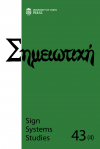C. S. Peirce on the dynamic object of a sign: From ontology to semiotics and back
C. S. Peirce on the dynamic object of a sign: From ontology to semiotics and back
Author(s): Helmut PapeSubject(s): Semiotics / Semiology, Semiology, Philosophy of Language
Published by: Tartu Ülikooli Kirjastus
Keywords: dynamic object; interpretational sequences; object unity; process ontology; transitivity; Peirce’s realism; contingent identity; inferential structures; teridentity; logical causality; collateral obse
Summary/Abstract: That reality, and in particular the (dynamic) objects of signs, are independent of our thoughts or other representations is a crucial thesis of Peirce’s realism. On the other hand, his semiotics implies the claim that all reality and all real objects are real for us only because of the signs we use. Do these two claims contradict, even exclude, eachother? I will argue that both Peirce’s metaphysics and his semiotics provide a natural via media: a structural account of the openness of processes, featuring transitive relations, connects process ontology implicit in his evolutionary metaphysics and the relational, quasi-inferential features embodied in interpretational sequences of signs. It is shown that Peirce’s notion of a sign, its normative role and his account of the directional force of objects implies a sort of logical causality that supports the unity of objects. In this way sign sequences are able to relate flexibly sign use with contextually specified independent objects. That is to say, relational properties of object-oriented chains of interpretations provide sign users with a flexible, fallibilistic instrument able to capture by contingent identity relations (teridentity) of the identity of objects in changing situations.
Journal: Σημειωτκή - Sign Systems Studies
- Issue Year: 43/2015
- Issue No: 4
- Page Range: 419-437
- Page Count: 19
- Language: English

